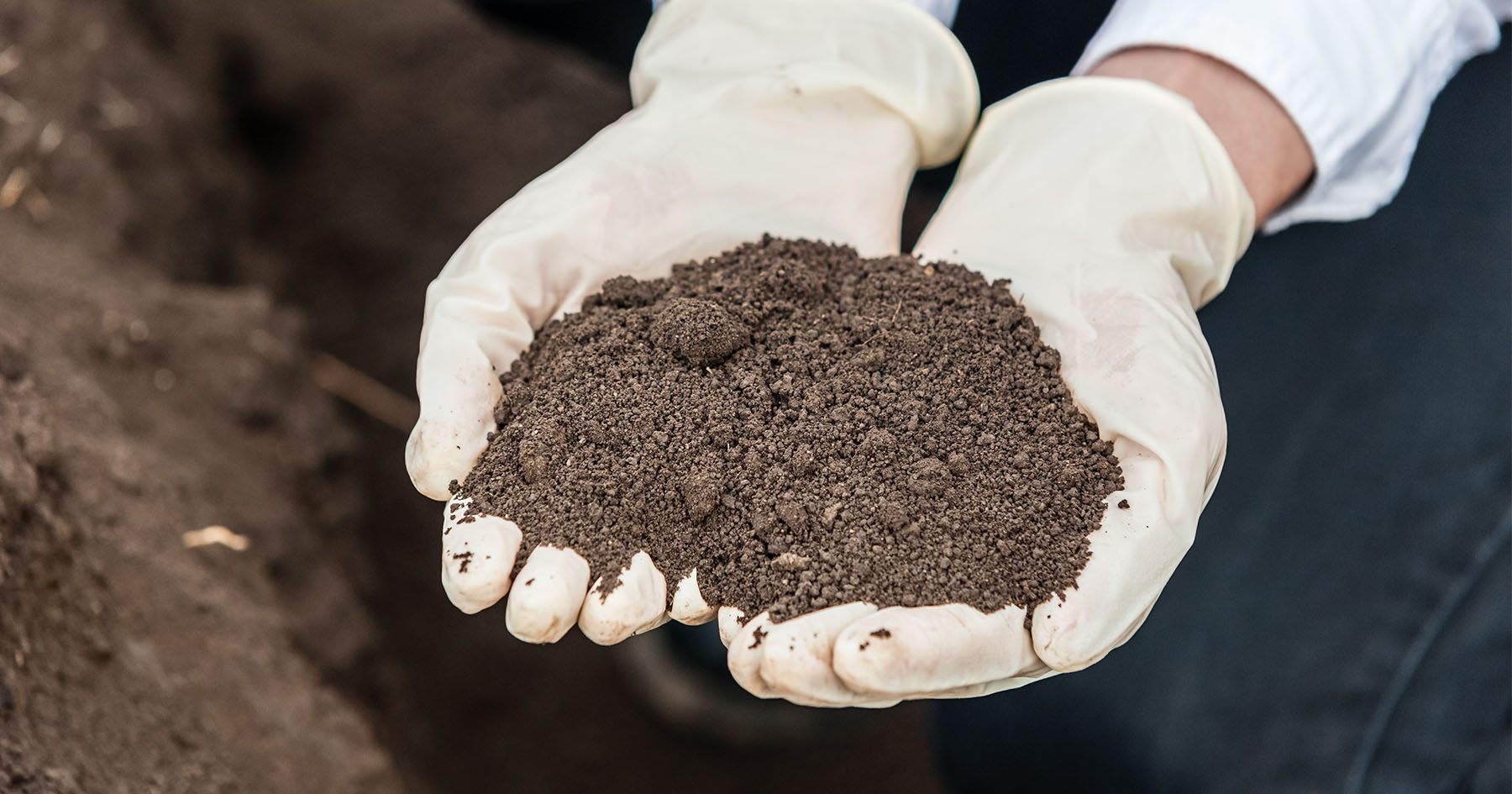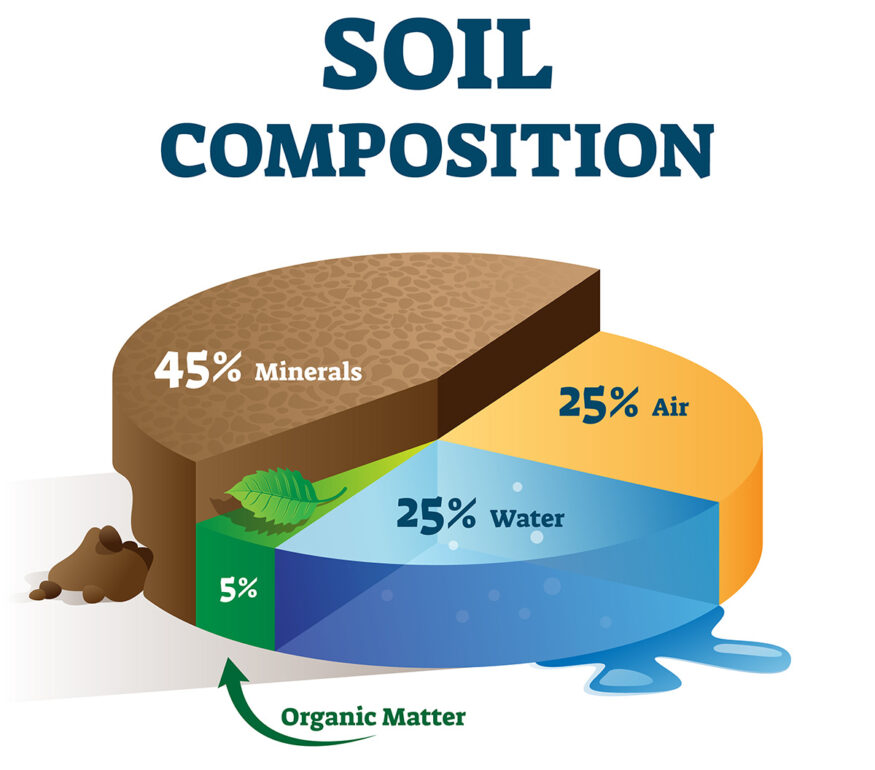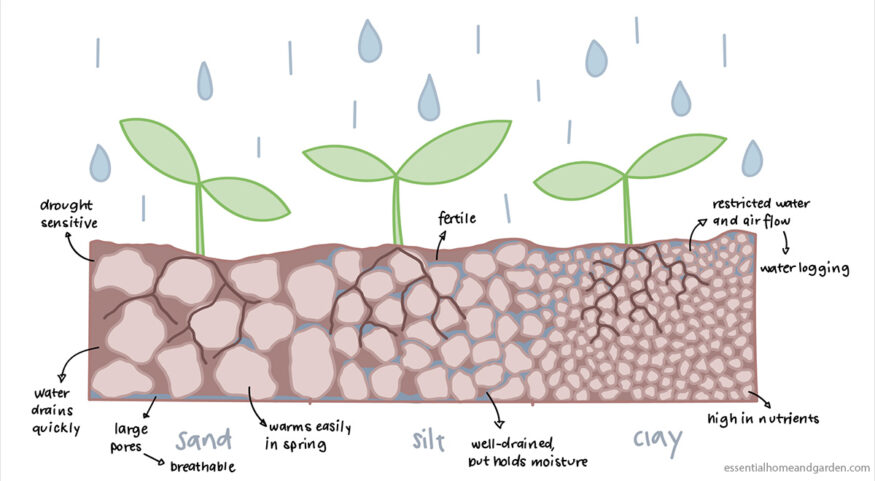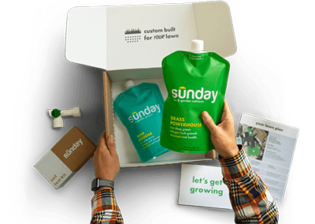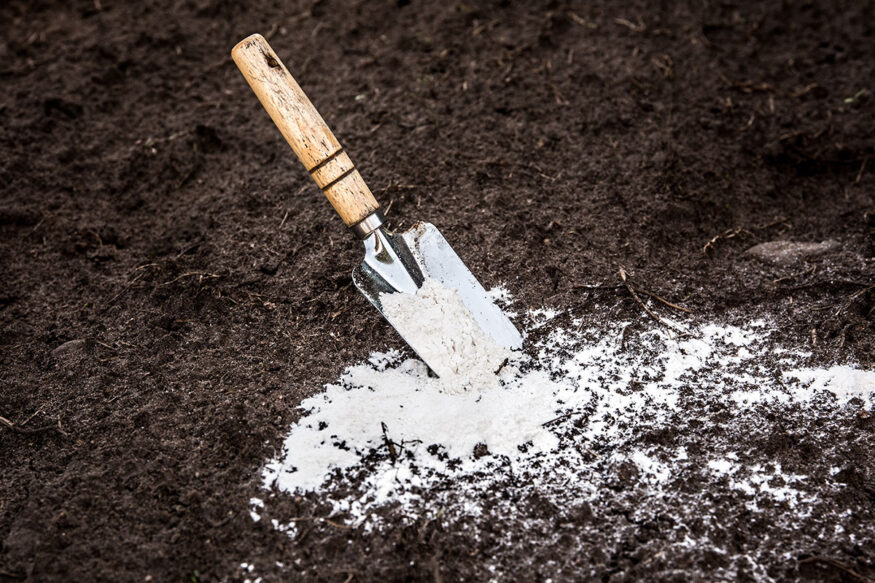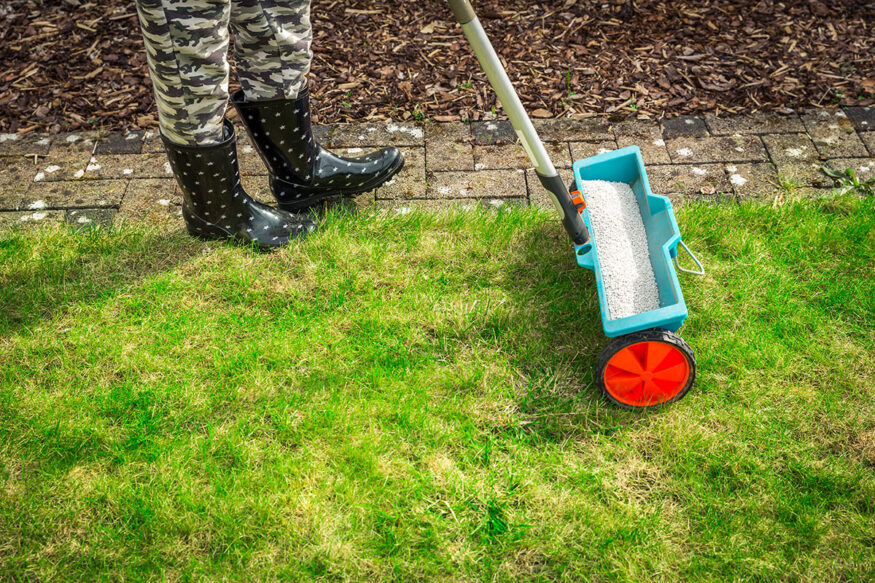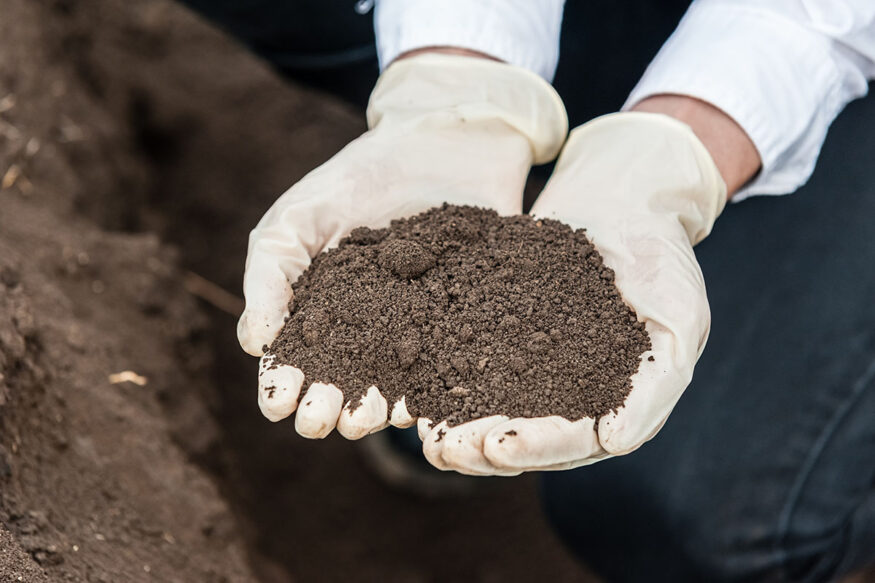The first step to a healthy lawn is healthy soil. When your soil has the right combination of physical features, nutrients, and organic compounds, your grass will thrive. And in turn, that healthy lawn will help keep your soil healthy to reduce the maintenance burden of your lawn.
Below, we’ll take an in-depth look at soil purpose and composition, and how to amend your soil when needed. We’ll give you our professional guidelines for adding soil amendments as well as some product recommendations for various soil needs.
With this comprehensive guide, you’ll get everything you need to improve the health of your soil for a healthy, beautiful lawn.
[ez-toc]
Understanding Soil: Its Purpose, Composition, and Texture
Before we can understand how to improve soil, we first need to look at the purpose and composition of the ground beneath our feet.
The Purpose of Soil
When considering the dirt beneath your lawn, it can be easy to think the purpose of soil is simply to grow grass and other vegetation. But soil’s functions go far beyond making our yards look good.
Soil is incredibly important for water quality and availability. Healthy soil helps purify water as it passes from the surface, through the dirt, and into aquifers, streams, and lakes. It also helps regulate the water supply by holding water in the ground and releasing it slowly, preventing runoff and helping direct water to underground caches.
Soil is also very important for modifying the Earth’s atmosphere. Soil emits important gasses, including oxygen and nitrogen. It also absorbs gasses, especially carbon dioxide and other harmful greenhouse gasses.
And, of course, soil provides a home for organisms, from plants and animals to beneficial microbes.
Soil Composition and Profile
Believe it or not, soil is mostly air and water. In healthy ecosystems, these two compounds account for about 50% of the soil’s volume.
The other half is made up mostly of minerals, like phosphorus, potassium, and calcium. A small percentage, generally less than 5%, is made up of organic material. This includes decaying plant and animal matter and microorganisms that live in the soil.
Most of the organic matter in soil is found in the top thin layer, which is known as humus. Below that is a mix of minerals and humus known as topsoil. Under the topsoil is a layer of leached minerals and minimal organic matter known as the eluviation layer.
Subsoil makes up the fourth soil horizon and consists of deposited minerals and metal salts. Under the subsoil is the parent rock layer which is made up of partly weathered rock. Below that is the bedrock, a hard layer of solid rock.
The roots of some plants can grow well into the subsoil. But dramatic differences between layers can prevent water and nutrients from moving freely through the horizons. This can restrict how deep roots can penetrate and cause growth problems above ground.
Soil Texture: Understanding High Clay, High Sand, Silty, and Loamy Soils
Layers of the soil above the rock horizon are made up of different amounts of clay, sand, and silt. Each of these types of dirt has a different texture that causes it to interact differently with water and nutrients.
High clay soil is made up of tiny particles that fit together with little to no space between them. When exposed to compression from foot traffic or other factors, the space between particles becomes even more compact until no air can get between them.
Clay soil is better at holding onto nutrients and water than other types. But compact clay and saturated clay soil hold little oxygen, which can suffocate roots. It can also cause root rot due to excessive moisture since it takes so long for water to run through clay soil.
High sand soil is made up of larger, oddly shaped particles that do not fit together well. This leads to a lot of air space between each particle. Water and nutrients tend to flow very quickly through this type of soil.
Sandy soil is very resistant to compaction and allows roots space to breathe and time to dry. But this soil is also prone to overdrying and becoming nutrient deficient.
Silty soil is made of particles somewhere between the size of those found in clay and sand. These medium-sized particles can fit tightly together and hold water and nutrients well.
Unlike clay, silt is not prone to becoming waterlogged. And it holds nutrients much better than sandy soil. But, this type of soil is prone to erosion by wind and rain because it’s so light and it can become compacted under pressure.
Loam is the perfect combination of silt, sand, and clay. Loamy soils can retain water and nutrients without becoming too compact or losing moisture too quickly or too slowly. Loam soil is made up of 40% sand, 40% silt, and 20% clay.
Often, when we amend soil texture, our goal is to achieve something close to loam.
Testing Soil: Infiltration Testing and Identifying the Best Soil for Grass
Most homeowners are familiar with soil tests that report nutrient composition. But testing the physical makeup of your soil is equally important. This can be done with infiltration testing.
This process consists of measuring the infiltration rate of water into the soil over time. When water soaks in too slowly or too quickly, that’s a sign of a problem.
When water pools on lawns, it can suffocate roots and cause rot. When it flows too fast over or through a section of lawn, it can leach nutrients and leave the grass to dry out too quickly.
While loam soil is a good starting point for home lawns, you will have to do more to determine the optimal soil composition for your grass. Different types of lawns have different preferences when it comes to soil texture, moisture retention, nutrient density, pH, and more.
Getting a comprehensive soil test that includes soil makeup is a great place to start. Many extension services offer this as do some subscription lawn maintenance services, like Sunday Lawn Care.
Struggling with poor soil quality? Get your soil tested and receive the perfect soil amendments delivered straight to your doorstep.
Use the code EHG20 to get an instant $20 discount!
- Experience personalized lawn care like never before: We offer custom lawn plans tailored to your soil's unique needs, factoring in climate data and specific lawn requirements.
- Enjoy convenience without compromise: Our products are not only easy to use but also safe for you, your pets, and the planet.
- Trust in our science-backed formulas: We believe in transparency. Our bio-based formulas contain effective, natural ingredients like seaweed, molasses, and iron.
- Benefit from expert support: Get one-on-one guidance from a real person and rest easy with our satisfaction guarantee.
- Don't wait! Transform your lawn today with Sunday Lawn Care.
Environmental Concerns Associated with Soil Use
Taking care of the soil in your yard is about more than just keeping your grass healthy.
Healthy soil is less prone to erosion, degradation, and loss of biodiversity. Soil health is vital to maintaining healthy vegetation that helps absorb carbon dioxide and pollutants from the air. The soil itself also helps to balance the effects of climate change by storing carbon dioxide to reduce atmospheric levels.
The What and Why of Soil Amendments
When your soil is more sand, clay, or silt than it is loam, soil amendments can help. They are also helpful for improving fertility, correcting pH imbalances, and revitalizing degraded dirt.
What Are Soil Amendments?
Soil amendments are organic or inorganic substances added to soil to improve its health. They can be used to improve the physical, chemical, or biological properties. Amending soil is typically done to enhance its fertility, texture, moisture-holding capacity, and nutrient density of soil.
Importance of Soil pH
When amending soil, it is important to keep in mind that what you add will likely change more than just the physical or chemical property you are hoping to adjust. Many amendments also affect the soil’s pH level.
The pH of soil is an important factor in nutrient availability and microbial activity. Most plants, including turf grasses, have a preferred pH they grow best at. This pH determines how well the grass uptakes certain nutrients which in turn determines growth quality.
pH can also affect the composition of the soil itself. Acidic soils are more prone to compaction while alkaline soils have higher concentrations of minerals that negatively affect moisture penetration.
When working to augment your soil, don’t forget to check your pH and consider how it will be affected by added materials.
While pH preference can vary by species, most cool-season grasses prefer soil between 6 and 7. Warm-season grasses tend to prefer more alkaline soils and thrive between 6.5 and 7.5.
How Soil Amendments Work
Common soil amendments come in two main categories: organic and inorganic. Both have their benefits and drawbacks and require careful consideration when used to amend soil for lawns.
Organic Soil Amendments
Organic soil amendments are any naturally derived substance that can be added to soil to improve it physically, chemically, or biologically.
The most common organic amendment options include compost, manure, leaf litter, and peat moss.
These substances release nutrients slowly as they break down, providing lasting fertilization and helping to feed the soil as well as your lawn. These materials are also great for increasing the aggregation of organic matter to enhance water infiltration and nutrient availability. Because beneficial microorganisms feed on organic matter, these substances are excellent for increasing overall soil health.
Organic amendments do have some drawbacks. Natural processes are required for nutrient release, which can be slow to begin. And the types of nutrients available can vary widely from batch to batch and material to material.
In general, though, organic soil amendments are a better choice than inorganic.
Here are some of the best times to treat your soil with organic amendments:
- When prepping the soil before putting down new sod or grass seed
- When tilling compacted soil before replacing lawn
- When reviving areas of dead grass
- When applying nutrients to nutrient-deficient lawn
- After aeration is done in the spring or fall
- Before grass greens up in the spring
Inorganic Soil Amendments
Inorganic soil amendments are non-living substances that can be used to modify soil properties. They can be used to add nutrients, change the pH, or change the texture of the soil. These substances are manufactured, mined, or created in the lab.
Some common inorganic amendments include synthetic fertilizers, lime, and perlite.
Inorganic amendments provide precise nutrient control and release nutrients into the soil very quickly. When used to adjust pH or texture, the results are equally fast. Often, inorganic amendments are convenient to store and apply due to their concentrated nature.
On the downside, inorganic substances contribute little to nothing to the organic matter component of soil or to the health of the microorganisms living within it. This often leads to reduced health of the soil and a growing dependence on synthetic nutrients to keep the lawn healthy. Long-term use of these substances can have a negative environmental impact, especially when they’re allowed to run into waterways and affect local ecosystems.
Still, there are times when an inorganic amendment can be helpful. These include:
- When addressing pH issues
- When quick nutrient correction is needed
- When fast relief is required for compact soil
Soil Amendments Comparison Chart
| Amendment | Organic or Inorganic | Characteristics | Best Use Cases | Potential Drawbacks |
|---|---|---|---|---|
| Compost | Organic | Improves soil structure, increases water retention, enhances nutrient-holding capacity, promotes beneficial microbial activity, and helps to increase soil fertility over time. | Improving soil structure and fertility | Can be nutrient-poor if not properly composed |
| Topsoil | Organic | Improves soil structure, enhances fertility, increases water holding capacity, and replenishes depleted soils. | Replenishing depleted soils | Quality can vary widely |
| Manure | Organic | Provides a balanced supply of organic matter, macronutrients, and micronutrients | Providing balanced nutrients | Can introduce weeds if not properly composted |
| Peat Moss | Organic | Increases organic matter content and improves moisture retention | Improving moisture retention in sandy soils | Can make soil too acidic if overused |
| Compost Tea | Organic | Provides beneficial microorganisms, nutrients, and organic matter | Boosting soil fertility and microbial activity | Effectiveness can vary based on preparation |
| Humic Acid | Organic | Improves soil structure, increases nutrient retention, enhances activity of beneficial microbes, chelates heavy metals | Improving nutrient retention and microbial activity | Can be expensive |
| Sand | Inorganic | Improves drainage, reduces compaction, and adjusts the soil texture. | Improving drainage in clay soils | Can make soil too dry if overused |
| Lime | Inorganic | Raises the pH of acidic soils, making them more alkaline | Correcting acidic soils | Can make soil too alkaline if overused |
| Sulfur | Inorganic | Lowers the pH of alkaline or overly basic soils | Correcting alkaline soils | Can make soil too acidic if overused |
| Gypsum | Inorganic | Helps break up compacted soils, improving drainage and aeration, and provides a source of calcium and sulfur | Improving compacted soils | Not effective in all soil types |
| Vermiculite | Inorganic | Improves water and nutrient retention | Improving water and nutrient retention in sandy soils | Can be expensive |
| Perlite | Inorganic | Improves drainage and aeration by creating air pockets | Improving aeration in compacted soils | Can float to the surface over time |
| Synthetic Fertilizer | Inorganic | Provides tailored micro and macronutrients to quickly correct nutrient deficiencies | Quickly correcting nutrient deficiencies | Can harm beneficial soil organisms if overused |
Please note that the “Potential Drawbacks” are general considerations and may not apply in all situations. Always consider the specific needs and conditions of your soil before choosing an amendment.
Soil Amendments to Improve Soil Texture
Soil texture is often a problem when the composition of the dirt is too sandy or has too much clay.
If your soil is high in clay and does not drain well or is too compacted, adding sand can help. When the problem is too much sand causing the soil to dry out quickly, adding some clay or silt can help.
But texture problems in soil go beyond not having the right ratios of sand, silt, and clay. When this is the case, adding other soil amendments may be necessary.
- Organic matter – compost, manure, and leaf litter improve texture by creating aggregates and binding soil particles together. This is helpful in both sandy and clay-packed soils.
- Peat Moss – Peat has a high water-holding capacity and improves drainage in compact clay soils while adding organic matter and supporting microbial health.
- Vermiculite – Vermiculite is a lightweight mineral that improves soil texture, water retention, and nutrient retention. It is especially useful for sandy soils that drain too quickly.
- Perlite – This lightweight volcanic glass improves soil texture and drainage, and prevents soil compaction, making it a good choice for clay-heavy soils.
- Gypsum – Gypsum is used to improve soil structure in compacted clay soils by breaking up clay particles to allow better water penetration.
- Composted bark or wood chips – This kind of organic matter can improve soil texture and drainage in clay soils.
Soil Amendments to Alter Soil pH
Soil pH for lawns typically needs to be between 6 and 7.5 for optimal growth. If your soil pH is too high or low for your specific species of grass, there are many soil amendments out there that can help.
To lower the pH of soil (acidify):
- Elemental Sulfur – This oxidizes and reacts with soil moisture and microorganisms, forming sulfuric acid, gradually lowering soil pH.
- Aluminum Sulfate – This is a fast-acting amendment used to lower soil pH. It needs to be applied carefully to avoid over-acidification.
To raise the pH of soil (alkalize):
- Lime – This common amendment slowly reacts with soil acidity, releasing calcium and raising the pH. Lime can be found in different forms, including calcitic lime and dolomitic lime.
- Wood Ash – Ash from hardwoods can be used to raise soil pH because it contains calcium carbonate and other alkaline compounds.
Anytime you’re using amendments to change soil pH, it’s important to add the substance in small increments and retest the soil pH often to avoid overdoing it.
Soil Amendments to Enhance Nutrient Content
The most common soil amendments used by homeowners are those that improve the nutrient content of their soil. This is important in lawns because nutrient depletion often occurs due to poor soil health and rapid grass growth.
When your grass is suffering, a quick application of synthetic fertilizer can help save it. But these quick fixes should not become the norm. Instead, focus on utilizing organic amendments that will improve natural nutrient density and availability over time by supporting soil health.
Here are some popular soil amendments that can help improve nutrient density in soil:
- Compost – This is a nutrient-rich organic amendment that can improve overall soil fertility by supplying macronutrients and micronutrients. Mix compost with the soil when putting down new sod or top-dress existing sod. You can also spray compost tea over established lawns.
- Manure – Cow, horse, and poultry manure are valuable organic amendments that enrich the soil with nutrients. Mix with soil when putting down new sod or top-dress existing lawns.
- Bone Meal – This slow-release organic amendment is derived from finely ground animal bones and is a good source of phosphorus and calcium. It can be sprinkled over existing lawns to address phosphorus deficiencies.
- Blood Meal – This organic, fast-acting amendment can quickly increase soil nitrogen levels. Spray it over existing lawns or freshly seeded plots.
- Fish Emulsion – This liquid organic amendment is made from fish waste and is a rich source of nitrogen, phosphorus, and trace elements. Spray over existing lawns as a natural fertilizer alternative.
- Rock Phosphate – Rock phosphate is a slow-release inorganic amendment that supplies phosphorus gradually over time to address long-term phosphorus deficiencies. Spread over established lawns when soil tests report consistent deficiencies in this nutrient.
- Kelp Meal – This vegan alternative to fish emulsion provides a range of nutrients, including potassium, nitrogen, and trace minerals. It also contains growth-promoting hormones and enhances soil microbial activity. Spray it over established lawns for reinvigorated growth and long-term health.
Soil Amendments for Specific Lawn Problems
Many of the common problems homeowners have with their lawns can be relieved by utilizing soil amendments to improve lawn health.
Here are some common lawn problems and the soil amendments that work to alleviate them:
- Compacted soil restricts root growth and inhibits water and nutrient absorption. Compost, peat moss, sand, and vermiculite can be added to improve soil structure, increase aeration, and enhance water infiltration and root penetration.
- Poor drainage can be counteracted by adding sand or perlite to your soil. These amendments improve soil drainage by creating pore spaces that allow excess water to move through the soil more efficiently.
- Low organic matter in the soil can result in poor nutrient availability and reduced water-holding capacity. Adding compost, well-rotted manure, and grass clippings can increase organic matter content, improve soil fertility, and enhance moisture retention.
- Thatch buildup can hinder water penetration and nutrient absorption. Aerating the lawn and topdressing with compost can help break down thatch and promote its decomposition by introducing beneficial microorganisms.
- Pest damage occurs when a lawn is not healthy enough to overcome infestation. Add organic matter, such as compost, manure, and humic acid, to support soil health and complete soil testing to determine if further amendments are needed to replenish nutrients or correct the pH.
The Role of Salts in Soil Amendments
Salts play an important role in many types of soil amendments.
Often, they are used to provide necessary nutrients. Potassium nitrate, calcium carbonate, and magnesium sulfate are all common salts found in organic and inorganic fertilizers. In addition to providing nutrients, salts can also help balance pH and improve the structure of the soil.
But when used too frequently or in high concentrations, salt can harm soil and plant health.
High soil salinity can hinder water uptake and nutrient absorption, especially in arid climates or yards with poor drainage. Sodium salts can be toxic to plants in high concentrations and displace other essential cations, disrupting nutrient balances in your grass.
To prevent salts from building up to dangerous levels, use soil amendments in moderation and complete frequent soil testing.
Guidelines for Applying Soil Amendments
How you will apply your soil amendment will depend on the type of amendment you’re using and the current state of your lawn.
Your options for soil amendments are much greater with bare soil awaiting new sod. But many amendments come in liquid form or can be “top-dressed” over existing lawns. In either case, these guidelines will help you find success.
Always Start with a Soil Test
No matter what issue you plan to address or what the state of your lawn is, a soil test should always be your first step.
These results can tell you what nutrients your soil needs, which it does not, and whether your pH is where it should be or if it could also use some adjustment.
Failing to do a soil test can leave you adding nutrients your lawn doesn’t need or overdoing pH adjustments. This can lead to damage not just to your grass but to surrounding ecosystems.
Struggling with poor soil quality? Get your soil tested and receive the perfect soil amendments delivered straight to your doorstep.
Use the code EHG20 to get an instant $20 discount!
- Experience personalized lawn care like never before: We offer custom lawn plans tailored to your soil's unique needs, factoring in climate data and specific lawn requirements.
- Enjoy convenience without compromise: Our products are not only easy to use but also safe for you, your pets, and the planet.
- Trust in our science-backed formulas: We believe in transparency. Our bio-based formulas contain effective, natural ingredients like seaweed, molasses, and iron.
- Benefit from expert support: Get one-on-one guidance from a real person and rest easy with our satisfaction guarantee.
- Don't wait! Transform your lawn today with Sunday Lawn Care.
Applying Soil Amendments to Your Lawn
Once you know what amendments your lawn needs, you are ready to apply them. Here are the general steps for applying the most common amendments to existing lawns.
- Prepare the lawn. Before applying amendments, mow your lawn and remove any debris and thatch buildup. It’s also a good idea to water the lawn thoroughly a day or two before applying amendments
- Calculate the application rate. Follow the instructions on the packaging or reference the web to determine the recommended application rate for your particular amendment. This will vary greatly depending on the specific amendment you’re using as well as the results of your soil test.
- Apply the amendments. For established lawns, spread the substance evenly over the grass using a granular spreader, hose attachment, or by hand. For bare soil, spread evenly and then till or rake the area to ensure the amendment gets mixed into the top layer of soil.
- Water and monitor. After applying the amendments, water the lawn thoroughly to help the substance integrate with the soil. Monitor the lawn regularly and repeat soil testing to assess the impact of the amendments and make any necessary adjustments in the future.
Top-Dressing to Improve Lawn Soil
While many amendments can be applied over lawns and absorbed seamlessly, such as granular treatments, liquids, and powders, some amendments are harder to work into established lawns.
Compost, manure, sand, topsoil, gypsum, and lime all require top dressing when added to existing lawns. You can do this following the same steps outlined above. But you will need to spend extra time preparing your lawn for the best results.
Mow the grass as short as it will tolerate and remove all dead thatch to expose bare dirt wherever possible.
To topdress a lawn, apply the amendment at the appropriate rate and then use a rake to smooth it over the lawn and help it penetrate the grass blades and reach the soil surface. Water the lawn lightly after to help settle the material. Avoid heavy watering until the amendment has bonded with the soil.
Environmental and Health Risks of Soil Amendments
When applied properly and in moderation, soil amendments can be very beneficial to your soil and lawn. But using amendments comes with some risks, both for you and the environment.
Nutrient runoff is a serious concern when adding nutrient-dense substrate to your lawn. When rain or excess watering washes it away before it has time to soak into the soil, these excess nutrients can pollute waterways and damage aquatic ecosystems. Even when fertilizers have time to soak in, excess use can lead to groundwater contamination.
Excess use of high-nutrient amendments can also cause soil degradation. These issues are most likely with synthetic fertilizers since they do nothing to support the soil biome or long-term nutrient availability.
Soil amendments can also be dangerous to your health.
Some contain heavy metals that can be dangerous if they contact your skin. Breathing in the dust created by some amendments, including some organic options, can be detrimental to your respiratory health.
It is always important to use soil amendments in moderation and choose organic or inert options when possible. No matter what kind of amendment you’re applying, utilize safety equipment to protect yourself from exposure.
Selecting and Sourcing Quality Soil Amendments
Selecting the best soil amendment is all about understanding the type of soil you have and identifying what it’s lacking.
Best Soil Amendments for Different Soil Types
If you are unsure of what type of solid you have there is a great guide here.
Sandy Soils
Sandy soils are known to have low nutrient retention and low water-holding capacity. The table below outlines some of the best soil amendments to improve sandy soil for healthier grass.
| Soil Amendment | Benefits in Sandy Soil | Best Used For | Cautions |
|---|---|---|---|
| Leaf Litter | Increases the soil’s ability to retain moisture and nutrients; enhances soil structure. | Improving soil moisture and nutrient levels. | Avoid using leaf litter from diseased plants. |
| Compost | Improves soil structure; increases moisture retention; adds essential nutrients. | General soil improvement. | Ensure compost is fully decomposed before use. |
| Peat Moss | Increases water-holding capacity; improves soil structure. | Improving water retention in very sandy soils. | Can be acidic; monitor soil pH. |
| Manure | Increases organic matter content and nutrient levels; improves water retention and soil structure. | Adding organic matter and nutrients. | Use well-rotted manure to avoid burning plants. |
| Vermiculite | Improves water and nutrient retention. | Improving water and nutrient retention in sandy soils. | Can be expensive for large areas. |
Related Article: The best grass seed types for sandy soil
Clay Heavy Soils
Clay-heavy soils are more likely to suffer from compaction, poor drainage, and root penetration difficulties. These amendments can be helpful in balancing clay soils and relieving these problems.
| Soil Amendment | Benefits in Clay Soil | Best Used For | Cautions |
|---|---|---|---|
| Organic Matter (compost, manure, peat moss, leaf litter) | Increases the soil’s ability to drain excess water; improves soil structure; enhances nutrient availability; breaks up clay particles for deeper root growth. | Improving soil drainage, structure, and nutrient availability. | Ensure organic matter is fully decomposed before use. |
| Gypsum | Reduces compaction; improves soil structure; helps break up clay particles to promote better water infiltration and drainage; reduces the risk of soil crusting. | Improving soil structure and water drainage. | Test soil before application; not all clay soils benefit from gypsum. |
| Sand | Helps create pore spaces, allowing water to move more freely and roots to penetrate the soil. | Improving soil drainage and root penetration. | Use coarse sand to avoid creating a hard, cement-like soil. |
| Perlite | Improves drainage and aeration by creating air pockets. | Improving soil aeration and drainage. | Can be dusty; use a mask when applying. |
Silt Soils
Silt soils perform better than clay and sand in many respects, but are prone to compaction. The amendments below can help improve the soil quality of silty soil for better growth.
| Soil Amendment | Benefits in Silt Soil | Best Used For | Cautions |
|---|---|---|---|
| Organic Matter (compost, manure, peat moss, leaf litter) | Improves soil structure, water-holding capacity, and nutrient content. | Enhancing soil structure, moisture retention, and nutrient levels. | Ensure organic matter is fully decomposed before use. |
| Coarse Sand or Gravel | Improves drainage and prevents compaction by creating pore spaces within the soil. | Improving soil drainage and preventing soil compaction. | Avoid using fine sand or gravel, which can lead to compaction. |
| Gypsum | Enhances drainage and reduces compaction by improving soil structure and increasing water infiltration. | Improving soil structure and drainage. | Test soil before application; not all silt soils benefit from gypsum. |
| Soil Conditioners (polymers, organic wetting agents) | Help prevent waterlogging and aid in evenly distributing moisture throughout the soil profile. | Preventing waterlogging and improving moisture distribution. | Follow manufacturer’s instructions for application rates and timing. |
Sourcing Quality Amendments
Once you’ve determined the best soil amendment for your lawn, you’ll need to choose a product to apply. For many amendments, there are a variety of options available and not all are high quality.
To ensure you get the best quality amendment possible, we recommend:
- Researching reputable suppliers – Check the reviews and certifications of local garden centers, nurseries, agricultural supply stores, and online retailers before choosing where to shop.
- Sourcing locally when possible – Local retailers are more likely to have products tailored to the specific needs of your region’s soil conditions.
- Ensuring ingredient quality and purity – Check the ingredient list and make sure the product contains high-quality, pure materials.
- Ensuring nutrient needs are met – The nutrient content of the chosen product should align with the needs of your soil and grass type.
- Ensuring compatibility with your soil – Consider the pH, texture, and drainage of your soil and choose amendments that are compatible.
- Consider the environmental impact – Opt for organic and sustainable options whenever possible.
- Seek recommendations and expert advice – Local agricultural extension services, horticultural experts, and experienced gardeners can provide valuable insights on suitable amendments for your specific soil needs.
Recommendations for Common Amendments
Many amendments, such as compost, manure, and leaf litter, are best sourced locally. Others may need to be ordered online to ensure you get the highest quality product available.
Below are some common soil amendments that are worth ordering and our favorite brands to consider.
Humic Acid
Humic acid is a naturally occurring organic substance found in soil, peat, and other organic materials. It improves soil structure, enhances nutrient availability, increases water-holding capacity, and promotes microbial activity.
Our choice of Humic Acid is made by Simple Lawn Solutions.
Humic DG
Humic DG is a specific type of humic acid product made by The Andersons company. By combining humic acid with natural binders, the company was able to create granules with a uniform size and shape that are easy to apply.
The Andersons Humic DG is a great product.
Elemental Sulfur
This soil amendment contains pure sulfur in its elemental form and is commonly used to lower soil pH in alkaline or neutral soils. When applied to lawns, elemental sulfur undergoes oxidation and is converted to sulfuric acid, thereby acidifying the soil. It can also help correct sulfur deficiencies.
Our pick of the Elemental Sulfur products in Greenway Biotech Organic Sulfur.
Lime
Lime is primarily composed of calcium carbonate or calcium hydroxide. When applied to the soil, it reacts with moisture and other components to release ions that help raise the pH of acidic soils to make them more alkaline.
If you want a top quality garden lime, then Organic Dolomite Lime is a great choice.
Aluminum Sulfate
When aluminum sulfate is applied to the soil, it undergoes a reaction with water and releases ions. The aluminum ions help to acidify the soil and are useful for lawns that are too alkaline. Aluminum sulfate can also be used to control moss growth on lawns.
We’ve always had great results from Bonide Garden Rich Aluminum Sulfate.
Moderation: The Best Soil Amendment Approach
With all soil amendments, but especially those listed above, moderation is key to achieving a healthy lawn and healthy soil.
When working to change the pH of your soil, start with a light application of the amendment and give it time to take effect before retesting. If needed, repeat with another light application and wait again before retesting.
By making moderate changes, you give the soil biome time to react and balance itself. When you allow this natural process time to play out, you reduce the likelihood of overdoing things and causing more problems than you solve.
Amending the soil in your yard can be a highly beneficial step toward a healthier, lower-maintenance lawn. But finding the right materials to use to complete the amendments is important for getting positive results.
Organic and inert inorganic amendments that work with the soil biome to balance the texture, structure, and nutrient profile are a better option than synthetic and chemical soil amendments. But in some cases, like when needing to modify soil pH, these treatments are necessary.
In either case, it’s important to work with moderation in mind. Overdoing any type of amendment is likely to cause more problems than solutions. Not only does doing too much put the health of your grass at risk, but it can be damaging to the environment.
By following these tips and referencing our guide above, you should have no problem finding the right soil amendments and application techniques to improve the health of your grass.
FAQs
What is the difference between fertilizer and soil amendment?
Fertilizers are applied to lawns and gardens to add nutrients to the soil. Amendments, on the other hand, are used to improve the physical properties of soil. Often, soil amendments can enhance the availability of nutrients and sustain balanced biomes to reduce the need for added nutrients.
Can you use too much soil amendment?
Yes, it is very possible to use too much soil amendment. Unnecessary or overapplied amendments can throw soil out of balance and cause new problems.
Inorganic amendments, such as lime and sulfur, can quickly change the pH of soil, making it toxic for many plants. The salts in some amendments can become overly concentrated when overused and kill soil microbes. It is best to approach all soil amendments with moderation.
What is the best way to add soil amendments?
Ideally, soil amendments are added to bare soil and mixed in. But they can also be spread and sprayed over existing lawns or foliage, where they will eventually move into the soil. Top dressing is a common way to add soil amendments, like topsoil and compost, to existing lawns.
How do I know if I need to amend my soil?
Start with a comprehensive soil test. Store-bought tests are great for detecting nutrient deficiencies and pH problems. But opting for a full lab soil test will give you more information about the composition of your soil and help you avoid problems with drainage and compaction.
